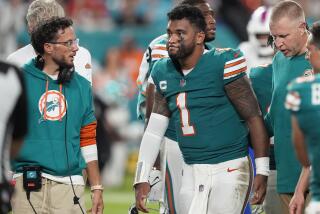Football injuries becoming a real head case
- Share via
Reporting from New York — Pittsburgh’s Ben Roethlisberger, the winning quarterback in last February’s Super Bowl, absorbed a violent blow to the head two weeks ago, suffered a concussion and sat out last weekend’s game.
Arizona’s Kurt Warner, his Super Bowl counterpart, also was sidelined last weekend by a concussion he suffered a week before.
And Cleveland’s Jamal Lewis, the last player to rush for 2,000 yards in a season, is dealing with a similar head injury that has ended his year -- and perhaps his career.
Concussions have always been part of football but have come in sharper focus recently, as the NFL confronts external and internal pressures to examine not just what occurs between the sidelines but between the ear holes.
The issue goes to the core of football values. Players are conditioned to play through injuries and, in many cases, to hide perceived weaknesses. Because there are no universally accepted sideline testing methods for head injuries -- beyond “how many fingers am I holding up,” that is -- it’s usually the players who wind up making the final decision about when they’re ready to return from a concussion.
And the peer pressure to tough it out and stay on the field couldn’t be higher.
“There used to be a saying where, if I’m going to get hurt and have to miss a game, I hope I have a cast on my leg, or have surgery on my knee, or have some proof positive,” said former NFL receiver Cris Collinsworth, now a TV commentator. “Because the lower-back injuries, the hamstring injuries, the ones that are sort of left to what the player has to say or the player’s input as to whether he plays, are awful injuries.
“There’s always some level of doubt and some other player saying, ‘Oh, I played with a concussion . . . I played with a lower-back injury . . . I played with a hamstring.’ Those are the ones that are really awful for the players. It puts the burden back on them.”
So why has the issue bobbed to the surface now? In large part because the league and its players are beginning to sit down at the bargaining table to hammer out a new contract. Among the significant issues are long-term benefits, and what role the NFL and the players’ union should play in providing care for retired players.
It’s an explosive issue because if the league acknowledges a link between head injuries and dementia in later life, it would be exposing itself to legal liabilities that could financially decimate the professional game.
In October, Commissioner Roger Goodell defended before Congress the league’s handling of head injuries, and, under questioning, would not make the connection between those injuries and long-term ailments. Last month, the co-chairmen of the league’s committee on brain injuries resigned after criticizing studies that drew those conclusions. Their own research was deemed by the players’ union to be biased and incomplete.
Goodell has instituted a new policy effective immediately that a player cannot return to a game or practice if he’s showing any signs or symptoms of a concussion. Under the old policy, a player could return if cleared by doctors, unless it was determined he’d lost consciousness.
Half of the 160 players surveyed recently by the Associated Press said they have suffered at least one concussion during their playing careers, and 30 admitted to hiding the effects of the injury in order to stay on the field.
Warner said he considered lying to team doctors in order to play in last Sunday’s game at Tennessee before ultimately deciding to turn over the reins to backup Matt Leinart.
“That’s the whole key with this issue, is a player being honest, which is hard,” Warner told the Arizona Republic. “I can tell you I wrestled with it when I was going down to that room to talk to them [before the game], saying, ‘Uh, do I want to stretch the truth a little bit? Do I not want to tell them everything so I can play?’ Because I know I could dictate that.”
Dr. David Patterson, medical director at Casa Colina Centers for Rehabilitation in Pomona, said players are putting themselves at serious risk when they do not allow themselves to recover fully from a brain injury before returning.
“If somebody strains a knee ligament, they can put a brace on it and go back and play. But the brain doesn’t work that way,” he said. “There are no intermediate stages for the brain to go through during recovery when it’s safe to go back. In fact, most current studies show that the brain’s not even amenable to therapeutic intervention during a phase when it needs to rest.
“Rest is the treatment.”
More to Read
Go beyond the scoreboard
Get the latest on L.A.'s teams in the daily Sports Report newsletter.
You may occasionally receive promotional content from the Los Angeles Times.











